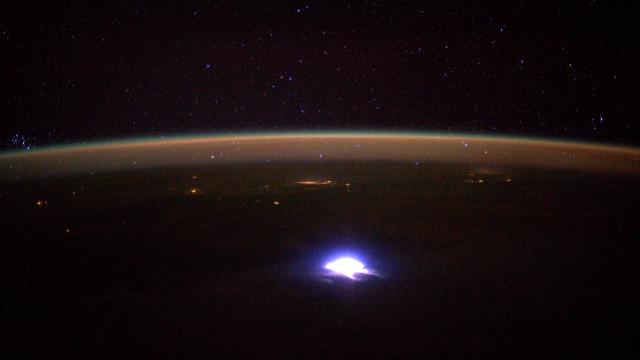Using satellites and ground stations, scientists have documented an epic lightning flash from 2017 that zipped above three states in the U.S. Southwest. Incredibly, scientists say discoveries of even bigger “megaflashes” are likely.
We normally think of lighting as something that moves along the vertical domain, but lightning can also move horizontally, particularly at high altitudes. New research published last week in the Bulletin of the American Meteorological Society confirms that lightning “megaflashes” are more common than typically appreciated. These superbolts often stretch for over 100 kilometres in length, including a record-breaking megaflash from 2017 that extended for over 500 kilometres above Texas, Oklahoma, and Kansas.
The length of vertical lightning flashes are typically around 6 to 10 kilometres, with the tallest reaching as high as 20 kilometres. The “horizontal extent of a flash within the cloud, however, can be much longer, reaching ‘mesoscale’ dimensions in large storm systems,” wrote the authors in the new study, led by Walter Lyons from FMA Research at Fort Collins in Colorado. By “mesoscale,” the authors are referring to lightning flashes longer than 100 kilometres. As for the total possible length that horizontal lightning flashes could stretch, that remains a scientific unknown.
Scientists were first made aware of mesoscale lightning flashes in the 1950s, but it wasn’t until the discovery of sprites—lightning the upper atmosphere—in 1989 that meteorologists started to appreciate the nature of the phenomenon. Sprites are bright electrical flashes that occur in clusters at altitudes reaching 50 to 90 kilometres above the Earth’s surface.
These flashes happen within an organised collections of individual thunderstorms known as mesoscale convective systems. In the right circumstances, these flashes can trigger a chain reaction that stretches across vast distances. In 2007, for example, scientists used 3D lightning mapping arrays to chronicle a 321-kilometre-long lightning flash above Oklahoma, a record-breaker at the time.
For the new study, the researchers sought to better understand and characterise the largest of these megaflashes. To that end, Lyons and his colleagues looked at data gathered by the Geostationary Lightning Mapper (GLM) aboard National Oceanic and Atmospheric Administration’s GOES 16 and GOES 17 satellites, launched in 2017 and 2018 respectively. The GLM is providing scientists with an unprecedented ability to track big storms from high above the Earth.
Using GOES data and ground-based lightning monitoring stations, the researchers found that megaflashes extending for 100 kilometres or more are actually quite common. As the new paper shows, however, the largest of these megaflashes are bigger than scientists thought.
On the morning of October 22, 2017, a squall line, that is, a string of thunderstorms forming ahead of a cold front, appeared in the southwestern U.S. At 1:13 a.m. local time, a lightning charge appeared above northern Texas, and it quickly spread in a north-northeast direction across Oklahoma, finally ending in southeastern Kansas. In total, the megaflash travelled over 500 kilometres, lighting up an area of 67,845 square kilometres.
This megaflash has not been confirmed by the World Meteorological Organisation (WMO), so it’s technically not an official world record. Writing in the paper, Lyons and his colleagues said it’s kind of a “moot” point given the strong likelihood of even longer megaflashes in that particular storm system and other storms since. What’s more, unpublished GOES data has already hinted at an even longer megaflash—a 673-kilometre-long behemoth from Brazil, which was recorded earlier this year.
So how big can megaflashes get? Apparently pretty big, according to the research.
“A megaflash, once initiated, appears able to propagate almost indefinitely as long as adequate contiguous charge reservoirs exist in the [storm system],” the authors wrote. “Is it possible that a future megaflash can attain a length of 1,000 km? We would not bet against that. Let the search begin.”
